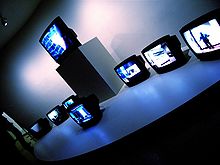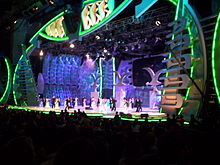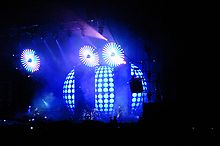- Soda Stereo
-
Soda Stereo 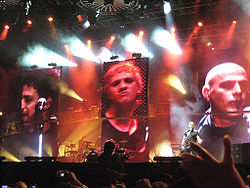
Soda Stereo, from left to right: Gustavo Cerati, Charly Alberti and Zeta Bosio.Background information Origin Buenos Aires, Argentina Genres Rock, alternative rock, experimental rock, art rock
Post-punk (1982-1990)
New Wave (1982-1990)Years active 1982–1997
2007 (tour)Labels Sony Music Associated acts Tweety González, Carlos Alomar Website www.sodastereo.com Members Gustavo Cerati
Zeta Bosio
Charly AlbertiSoda Stereo were an Argentine rock band who are recognized as one of the most influential and important Latin American and Ibero-American bands of all time.[1][2] They were a power trio formed in 1982 by lead singer-songwriter and guitarist Gustavo Cerati, bassist and backing vocalist Héctor "Zeta" Bosio, and drummer Charly Alberti at Buenos Aires, Argentina.
Soda Stereo were the first Latin rock group to achieve success throughout South and Central America. They helped popularize the Rock En Español, Ibero-American Rock, and Latin Rock genres to a mainstream audience. The band established what would become the template for many other popular Spanish-speaking rock music groups. Soda Stereo has topped the all time lists in much of Latin America and in their native Argentina, where they set landmarks in record sales and concert attendances.[3][4] In theirs active career they sold over 7 million of albums only in Latin America and this number has continued to rise after the separation of the band. In 2002 Soda Stereo was awarded the Legend Prize by MTV Latin America, the first prize to be awarded of its kind.
Their career spanned from 1982–1997, followed by a short comeback tour in 2007-2008. Soda Stereo began as a new wave outfit influenced by The Police, The Specials, Television, The Cure, XTC, and other Argentine rock. Their music evolved toward a heavier alternative rock sound throughout the 90’s, eventually drawing influences from classic rock, grunge, progressive rock, shoegaze, and Britpop.
Four of their albums have been included in the list of Top 250 all time Latin rock: Canción Animal (Nº. 2), Comfort y Música Para Volar (Nº. 15), Signos (Nº. 40), Sueño Stereo (Nº 41), and two of their albums have been included in the Rolling Stone Argentina list, "Los 100 mejores discos del rock nacional" (The 100 best albums of national rock): Canción Animal (No. 9) and Signos (No. 25).[5][6][7]
History
From Stereotypes to Soda Stereo (1982-1984)
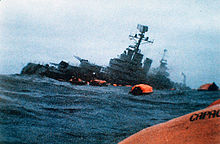 The sinking of the Argentinean Cruiser General Belgrano in 1982 outside the war zone, Falklands War. The loss of the war caused the Argentinian dictatorship to collapse opening the door for democracy in 1983. It was at that moment that Soda Stereo was born
The sinking of the Argentinean Cruiser General Belgrano in 1982 outside the war zone, Falklands War. The loss of the war caused the Argentinian dictatorship to collapse opening the door for democracy in 1983. It was at that moment that Soda Stereo was born
In the summer of 1982 Gustavo Cerati at 22 years of age and Hector Zeta Bosio at 23 years of age collided at Punta del Este, Uruguay. Cerati with his group Sauvage[8] and Bosio with The Morgan, a band he shared with Sandra Baylac, Hugo Dop, Christian Hansen, Pablo Rodriguez,(Los Auténticos Decadentes), Charly Amato, Osvaldo Kaplan, and Andres Calamaro.[9] Cerati and Bosio established a friendship and a musical bond that encourage them to start playing together. Cerati first joined Bosio’s group The Morgan, then formed Stress with Charly Amato and drummer Pablo Guadalupe. He also worked on the project Erekto with Andres Calamaro. According to Cerati both projects did not meet his expectations.
At the time Carlos Ficcichia, legal name of Charly Alberti would incessantly call Cerati's house asking for Maria Laura Cerati, Gustavo’s sister. Alberti wanted to ask her out, but she thought he was too “pesado” (stiff) and did not want to go out with him.[10] In one instance when Gustavo answered the phone, they entered a lengthy conversation about music. Alberti mentioned that he was a drummer and the son of the famous Jazz drummer, Tito Alberti, songwriter of a well known Argentinian children's song, “El Elefante Trompita” (Little Trunk Elephant).[11] After hearing Alberti play, they asked him to join the band, but first he had to cut his hair.
After a few experiments (Aerosol, Side Car) the three adopted the name Los Estereotipos (The Stereotypes), referencing a song by The Specials which they passionately listened to for few months.[12] During that time period they record a demo with Richard Coleman on guitars. Soda initially recruited Coleman to beef up the guitar sound but Coleman recognized that the band sounded better without him and quit in good terms, leaving the definitive trio of Gustavo Cerati, Zeta Bosio, and Charly Alberti.[10] The songs recorded were, “Porque No Puedo Ser Del Jet Set?” (Why Can’t I be Part of the Jet Set?), “Dime Sebastian” (Tell Me Sebastian), and “Debo Soñar” (Must Dream) by Ulises Butrón, in which Ulises Butrón played guitars and Daniel Melero played keyboards. Following that episode, the names “Soda” and “Stereo” appeared, which resulted in “Soda Stereo.[13]
Regarding the meaning and use of the word “soda:”
They say that they make music with bubbles. But instead of referring to luxurious champagne bubbles, they affirm that they assume the representative ordinary and popular Sifón, or carbonated soft drinks[14]
The first show under the name "Soda Stereo" occurred on December 1982. The occasion was Alfredo Lois birthday party. Lois was Cerati and Bosio's university classmate. He would go on to become Soda's video director as well as their visual and stylistic guru. Lois was later recognized by Cerati himself as “the fourth Soda”.[15]
In July 1983 the band made their debut at the discothèque Airport in the Buenos Aires neighborhood of Belgrano. According to the band:
Our debut was at a fashion show at the Disco Airport, which was close to where we practiced in Buenos Aires. Nobody gave us a nod. The three of us played on a very deficient sound system. But we were happy, even though no one paid attention. We really looked like a punk group, we didn’t know how to play and the sound was loud, even though it was just that[15]
Following that gig, Soda Stereo began to play the underground circuit of Buenos Aires, making a name for themselves alongside other emerging bands of the time, such as Sumo, Los Twist, Los Encargados (with Daniel Melero), and other bands. Soda took up residency at the traditional and deteriorated Cabaret Marabú, located at Maipú 359.[10] In those early shows, Soda would play songs like “Héroes de la Serie” (Heroe of the series), “La Vi Parada Alli” (I saw her standing there), and “Vamos a La Playa” (Let’s go to the beach), along with other songs that appeared on their second demo.[16] On one occasion at the Café Einstein, Luca Prodan approached Cerati, whom he considered “a chetito,[note 1][17]” and joined Soda in a cover of a Police song.[10]
The band began to attract a bit of notoriety. One night they were called to a pub to substitute for the group Nylon. There began a period of constant shows which concluded at Bar Zero, a place that excluded the Porteño underground, along with Café Einstein. On their third show, Horacio Martinez, a historic Argentinian rock producer and “talent hunter” heard them and quickly took them to record for CBS. This came to fruition in 1984 when Soda signed to the Rodríguez Ares agency.[10][18]
At the time Soda Stereo was already known as being a band that worked hard on their image and long before the recording of their first album they decided to film a video clip, which they financed with their own money.[19] was in charge of the visuals and the graphic designs featured on the fliers and posters for their live performances. It was Alfredo who decided to edit a video clip before the release of the album, something that is quite common today but totally unusual for the time. The song chosen was “Dietético” (Dietitian). The filming was realized with “borrowed” equipment from Cablevision, where Zeta Bosio worked as a production assistant.[12]
First Album and Chateau Rock '85 (1984-1985)
Soda Stereo recorded their debut during the second half of 1984. The album was produced by Federico Moura, vocalist for Virus. By that time, Moura and Cerati had developed a fruitful artistic relationship. The recording took place in the defunct studios of CBS on Paraguay street. The end result was cooler sound than of the live shows, which the bands were pleased with. The trio was aided by Daniel Melero on keys and Gonzo Palacios on sax. Both were listed as “guest musicians,” a practice which would become common for Soda throughout their career. Such guest musicians would be recognized by the public as the “fourth Sodas”.[20]
The attention garnered by Soda was manifested in their playing of larger and larger venues. First was “La Esquina Del Sol” in Palermo. “El Recital De Los Lagos” on the 1st and 2 December was their first multi-headlining show with top Argentinian acts .[21] The show was hosted by Argentinean Television personality Juan Alberto Badía.
Soda Stereo presented their debut album at El Teatro Astros on the 14th of December 1984, it was their first show there. The stage was designed by Alfredo Lois, who for the occasion located 26 television sets in the background. The TV's were turned on and out of sync with each other - the theme of “Sobredosis de TV” (TV Overdose). The TV's, together with a large amount of smoke, created an unusual but captivating visual effect[22]
On the 26th of January 1985 Soda played the Rock in Bali festival in Argentinian port city of Mar Del Plata. On the 17th of March they played the Festival Chateu Rock ’85 at the Estadio Olímpico Chateau Carreras in Córdoba Province. The official biography of the band attach great importance to this appearance indicating that the band played for 15 thousand people and that they were the revelation of the festival.[23] However, Córdoba media outlets claim that, "only half the number of people actually showed up and that Soda were hardly noticed because their first record had was just released a few months earlier.” They also added “Raul Porchetto was the biggest draw of the night”.[24] Regardless, their presence at Chateau sparked a personal relationship between the band the youth of Córdoba, it marked the moment that the band began to take flight toward national stardom.[25]
The success of the band began at a very pecuiliar time, related, on the one hand with the return of democracy to Argentina (December 10, 1983), and on the other hand, with increasing notions of postmodernism, particularly in the way the 80’s youth created their role in a newly democratic society, one that had just emerged from bloody Dictatorship and War.
Years later, Zeta Bosio would reflect on this juncture:
The democracy produced the adrenalin of something new, something was occurring, I knew I was going to make changes without knowing how. There was more air for us to make things and to wander, and we were a band of kids that wanted to make trouble. Our attention was on punk and on trying to show that there was something else that was more direct[25]
On the 13th of October of that year, Soda played in front of a large audience in Buenos Aires as part of the third night of the Festival of Rock and Pop Held at the José Amalfitani Stadium home of the soccer club Velez Sarsfield . They shared the stage with INXS, Nina Hagen, Charly Garcia, Virus, and Sumo, among others. By then Fabian “Vön” Quintero and Gonzo Palacios were “stable guests.”
Nada Personal and Obras 1985-1986
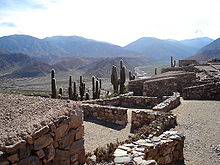 The Video for Cuando pase el temblor (1986), directed by Alfredo Lois was filmed at the -pre-Incan ruins of Pucará de Tilcara, in Jujuy. Soda fused rock and carnavalito (traditional Andean music. The video was nominated as the finalist for the 12th World Festival of Video and TV in Acapulco.
The Video for Cuando pase el temblor (1986), directed by Alfredo Lois was filmed at the -pre-Incan ruins of Pucará de Tilcara, in Jujuy. Soda fused rock and carnavalito (traditional Andean music. The video was nominated as the finalist for the 12th World Festival of Video and TV in Acapulco.
Soda’s second álbum Nada Personal was edited on October 1985. During the summer the group toured the touristic centers of Argentina, playing in Mar de Plata, Villa Gesell, and Pinamar. Finalizing the tour with a consecrating concert at the Festival De la Falda in Córdoba, which featured Andres Calamaro and Charly García on keyboards on “Jet Set.”
In April the band decided to officially present the album at a concert at the Estadio Obras Sanitarias in Buenos Aires. There they realized four historic shows with a total attendance of 20,000 spectators. Footage from the first show was edited into a long play video.,[26] the noted music critic and founder of the groundbreaking Rock & Pop Radio in Buenos Aires, thus ending his chronicle of the concert, had this to say:
"We are facing the most powerful group in the country ... The best parameter to measure this presentation is that it was short, it seemed to have lasted ten minutes or so and people were left wanting more. The outpouring of the stadium was a general murmur of the songs from Soda Stereo. The rain, the traffic on Avenida del Libertador was cluttered by those entering and leaving. The last hot dog of the night and a healthy sense of well being, leave no room for existential questions. I then put my jaw back in place and went singing softly “Estoy Azulado” between the rain on Libertador.[27] "
After these concerts records sales began to increase at an accelerated rate, quickly passing the Gold certification that they had achieved during the summer, platinum certification, and finally double platinum in the following months. Without abandoning the danceable rhythms, the second LP resulted in more depth in the lyrics and a melodical maturity. The album marked the definitive consecration of Soda Stereo to the Argentenian public.
The Conquest of Latin America (1986-1989)
In 1986 Chilean Youth received Soda Stereo as popular idols. The song that created this first contact was Personal” (Nothing Personal) which became a radio hit. A little later in February of 1987 Soda a has a strong showing at the Viña del Mar International Song Festival, again in Chile. This, in effect, opened the doors to the rest of Latin America.[5]
In 1986 Soda Stereo realized their first Latin American tour, called Signos - still touring with the Nada Personal record. The band played in Colombia, Costa Rica Peru, and Chile with considerable success. In Chile they realized four shows in Santiago, on the 21,22,24, and 25 November, and one in Valparaíso on the 22nd of November of 86 In November 1986 Soda arrived in Peru for the first time and revolutionized the market. Their album sales were enormous and their three shows at the Amauta Coliseum were unforgettable.
At that time Latin Rock was not that popular with the youth of Latin America (with the exceptions of Argentina and Uruguay) and bands were not accustomed to international tours.[28]
On the 10th of November 1986 the band released their third album Signos. Signos with its lead single "Persiana Americana" (American Blinds) was a key step for Soda Stereo who by now had come under a great deal of stress due to ever increasing factors: sales expectations, external pressures, the risk of failure, and internal tensions. The band was joined in the studio by Fabián Vön Quintiero on keys, Richard Coleman on guitar and Celsa Mel Gowland on back up vocals. Signos became the first Argentinian Rock album to be released on Compact Disc. It was manufactured in the Netherlands and distributed throughout Latin America.[29]
On the 3rd of December Soda made their first appearance in Ecuador. In early 1987 Soda returned to Chile, this time to the Viña del Mar International Song Festival where they won the prize “Antorcha de Plata” (Silver Torch). The festival was broadcast via television to many Latin American countries, expanding the band’s fame throughout the continent. It did not take long to transform itself into a massive unconditional adhesion which was called “Sodamania”.
On the 23rd of April 1987, Soda broke records for ticket sales in Paraguay with their show at the Yacht Club. Meanwhile Signos reached Platinum status in Argentina, triple platinum in Perú and double platinum in Chile. Soda’s first show in Mexico occurred on the 4th of August in 1987 at the Magic Circus in Mexico City.
The Signos tour was a milestone for Soda as they played 22 concerts in 17 cities to almost 350,000 fans, in the process opening up the idea that Latin Rock can transcend the nationalities of the bands, something that would come to fruition in the upcoming decade. With live recordings from different shows, a live album Ruido Blanco was compiled in 1987. Mixed in Barbados, it was considered by Rolling Stone (Argentina) to be one of the top 5 live albums of Argentinean Rock[30]
In late 1988 Soda began to work on a new album alongside Puerto Rican producer Carlos Alomar. Alomar had worked with David Bowie, Mick Jagger, Simple Minds, Iggy Pop, and Paul McCartney, among others. Doble Vida (Double Life) was recorded and mixed in New York City. It was the first record by an Argentinean band to be completely recorded abroad.[31]
The album produced four singles, "Picnic en el 4B" (Picnic in Room 4b), "En la Ciudad de la Furia" (In the City of Fury), and "Lo Que Sangra (La Cúpula)" (That Which Bleeds (The Dome), and “Corazon Delator” (Tell-Tale Heart). The video for “En La Ciudad de La Furia” was a finalist for an MTV Video Award in the category of best foreign video (there was no Latin MTV at the time).
After more than a year without playing in Buenos Aires, Soda showcased Doble Vida at the hockey field at Obras in front of 25,000 fans. To top of a stellar year, Soda headlined the Three Days for Democracy Festival, which took place in Buenos Aires on the intersection of Avenida del Libertador and Nueve De Julio. The show was attended by 150,000 people and Soda shared the stage with Luis Alberto Spinetta Fito Páez, Los Ratones Paranoicos, Man Ray, and others.
With sales of a million copies of Doble Vida under their belt, Soda began a massive tour in early 1989. The tour began with 30 shows in Argentina, covering most of the country, which were attended by nearly 270,000 thousand fans. These shows were followed by a new Latin American tour (their third), which cemented a massive following in Mexico.
Near the end of 1989 Soda records a new version of “Languis” (from Doble Vida) and a new song titled “Mundo de Quimeras” (World of Chimeras). Both songs were released in the EP Languis (1989) along with remixes of “En El Borde” and “Lo Que Sangra (La Cúpula)”. Following the release of Languis Soda played two sold out shows at The Palace in Los Angeles, becoming the second Rock en Español to play in the United States, following Miguel Mateos.
The Consecration: Canción animal (1990-1991)
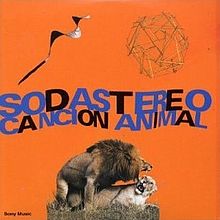 The album Canción Animal, released in 1990, is considered to be one of the best albums of all time of the Latin Rock genre.[by whom?]
The album Canción Animal, released in 1990, is considered to be one of the best albums of all time of the Latin Rock genre.[by whom?]
In early 1990 the band co-headlined a show for 32,000 people with British new wave band Tears for Fears at the Jose Amalfitani Stadium in Buenos Aires.
Soda Stereo then traveled to Criteria Studios in Miami, Florida to begin work on their fifth album. They would enlist the help of Daniel Melero, Andrea Álvarez, and Tweety González (all very important figures in the Argentinian rock scene of the time.
The resulting album Canción Animal(1990) is considered to be one of the best albums in the history of Latin rock. It contains their most well known song “De Música Ligera” (Of Light Music), as well as other classics such as “Cancion Animal” (Animal Song), “Un Million de Años Luz” (A Million Light Years), “En el Septimo Dia” (On the Seventh Day), and “Te Para Tres” (Tea For Three). These songs are considered to be the band's strongest and at the same time are their most popular.[32] Overall, the album is considered as the most consistent work by the band, along with Signos.[32]
Their Massive Tour Animal (1990–1991) included 30 Argentinean cities, many which had not been visited by a band with the reach of Soda Stereo. The cities visited in Argentina were: San Juan, Santa Fe de la Vera Cruz, Junín, Clorinda, Puerto Iguazú, Trelew, Neuquén, Santa Rosa, Trenque Lauquen Mendoza, Córdoba, Río Cuarto, Santiago del Estero, San Miguel de Tucumán, Salta, Rosario, Buenos Aires, Olavarria, Pergamino. International cities included: Santiago de Chile, Asunción, Punta del Este, Barquisimeto, Caracas, Valencia, Mérida, San Cristóbal, Mexico City, Monterrey, Guadalajara, Mexicali, and Tijuana.
The Tour Animal finished with 14 consecutive shows at the Grand Rex Theater in Buenos Aires. With a 3,300 person capacity, this was a noticeable achievement at the time.[33] Some of the Grand Rex shows would appear on the live EP Rex Mix (1991), which included remixed versions of a new song, “No Necesito Verte (Para Saberlo)” (I don’t Need to See You - To Know).
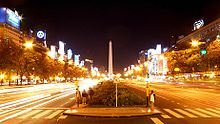 La Avenida 9 de Julio en Buenos Aires. On December 14, 1991 Soda gave a free concert here to more than 250,000 people.
La Avenida 9 de Julio en Buenos Aires. On December 14, 1991 Soda gave a free concert here to more than 250,000 people.
By late 1991 Soda’s continental success brought the band to the attention of MTV News Europe who began to take notice of what was taking place in Latin America, particularly with Rock en Español. MTV unconditionally dedicated a whole show to Soda - a first for non English singing band.[34]
In May 1992 Soda embarked on a tour of Spain with shows in Madrid, Oviedo, Sevilla, Valencia, and Barcelona.The lackluster results of the Spanish tour, compared to the fervor they were accustomed to in Latin America, left a sour taste in their mouths. Nevertheless, it did serve as a valid experience, specifically in bringing the band back to earth. To put it bluntly: Spain was in no way a failure, but was far from the success that Soda had been used to in Latin America, in the end it was a good learning experience.[34]
The Experimentation: Dynamo (1992-1994)
After that moment, Soda came to the realization that they were at the center of the scene. Therefore, they decided to give some space to the musical experimentation and openly propel what would be known as La Movida Sonica (The Sonic Movement). Nearing the end of 1992 Soda released their sixth studio album Dynamo. Dynamo was christened with six concerts at Obras. Each show featured a different band as support, Babasonicos, Juana La Loca, Martes Menta and Tia Newton, The Sonic Movement of which Demonios de Tasmania and los Brujos would also be part of. This would be derivative of something called “El Nuevo Rock Argentino" (The New Argentinian Rock).[35] Massacre, and El Otro Yo were also considered part of the movement.[36] The band also showcased the album in its entirety in a local talk-show, Fax. This was the first stereophonic TV transmission in Argentina.[22]
According to Gustavo Cerati, Dynamo consisted of taking Canción Animal and destroying it." Cerati explains, "It is as if we took Canción Animal and put it under water. And, at a sonic level, we wanted to produce that, the songs had more to do with something hypnotic. The idea was to remix it, to mix it with something more dance and include something more trance in our music. I know that those who understood that record loved it and it is the same with me.[15]
According to AllMusic Dynamo,was Soda's least popular album and at the same time their most experimental work.[37] Dynamo did not sell as expected, in large part because the band decided to change record company immediately after recording it. Sony at the time, had no intentions of promoting a group that had just emigrated from BMG and BMG could not promote another foreign product.
In January of 1993 Soda began their sixth tour of Latin America, visiting Mexico, Chile, Paraguay, and Venezuela. During the middle of the tour, the trio decided to take a long rest which fueled rumors of a break up. There had been talk of dates in the United States, Spain and other countries, but diverse factors during late 1993 and early 1994 forced the group to take a “rest” from Soda Stereo.
1994 was the worst year for Soda. On the 4th of July, Zeta’s two young sons died in an absurd transit accident in Argentina. This event would deeply affect Zeta on both a personal and professional level. By unanimous decision Soda decided to distance themselves from the myth for a while and at the same time to evaluate the possibility of a definitive separation.
During this hiatus, Gustavo released his first solo project: Amor Amarillo (Yellow Love), (ironically, Gustavo had mentioned that he had no interest in a solo career). Zeta dedicated himself to the production of other pands (Peligrosos Gorriones and Aguirre). Charly disappeared from the music scene to focus on personal projects.
At the end of 1994 Zona de Promesas, a compilation of remixes and classic Soda songs, including the unreleased song that gave the album its name, was released,
Sueño Stereo (Stereo Dream) (1995-1997)
 In 1995 Soda Release Sueño Stereo, the last of their 7 studio albums. In this album the speaker was utilized as a powerful symbol: the cover contains three speakers (a bigger one in the middle), posing as ovules surrounded by spermatozoa speakers. The image of the speaker is also used in the video for Ella usó mi cabeza como un revólver ("She Used My Head Like a Revolver")[38]
In 1995 Soda Release Sueño Stereo, the last of their 7 studio albums. In this album the speaker was utilized as a powerful symbol: the cover contains three speakers (a bigger one in the middle), posing as ovules surrounded by spermatozoa speakers. The image of the speaker is also used in the video for Ella usó mi cabeza como un revólver ("She Used My Head Like a Revolver")[38]
After a three year absence, on the 29th of June 1995, Soda release Sueño Stereo (Stereo Dream), their 7th and final studio album. The album was an instant hit quickly reaching platinum disc in Argentina 15 days after its release.[39] The album was powered by the radio hit “Zoom” and the promotional video for “Ella usó mi cabeza como un revólver” (She Used My Head Like a Revolver), which in 1996 won the viewers choice award presented by MTV Latin America. This was a maximum accolade given that this award at the time, since the actual award would not be established until 2002 for Latin MTV.
According to Cerati:
Sueño Stereo took two years to conceive. It would be illogical to say that this was Soda’s masterpiece, but it was the most real expression by the group at the time, because we were stripped of the need of having a group in the future, or of being the best for another ten years. We had already passed through a lot of things and the band itself felt classic. On the other hand, we were very proud of what Dynamo had promoted and its subsequent interpretation. Then, Sueño Stereo had the pressure of not pressuring us. The band had to deliver something important, it couldn’t be a little record. Besides, we had to find ourselves again after a while and allow the music to flow, without thinking too much about taking or step or something like that. In the end, Sueño Stereo is one of the most innovative records of our career, without us trying to make it so -because of its sonic combinations, its lyrics, and because of its sound.[15]
The álbum bécame the axis for the extensive Gira Sueño Stereo (Sueño Stereo Tour), which began on September 8 in Buenos Aires, at the Grand Rex Theater. It covered Venezuela, Colombia, Perú, Panamá, México and the United States (Los Angeles, Chicago, New York, and Miami). The tour finished on the 24th of April 1996 at the Teatro Teletón in Santiago de Chile.
In mid 1996 Soda was invited to Miami by MTV to record a session for MTV's acoustic show, MTV Unplugged. After a few refusals by the band, Soda was able to convince the network to accept an offer where the band would play plugged in, but with modifications such as orchestration including new arrangements of some of their classic songs. The result was an eclectic mix of music, some electric, some acoustic, but all bearing the Soda Signature style. A highlight of the album was a soaring rendition of “En La Ciudad De La Furia.” where the chorus was sung by Andrea Echeverri of the Colombian Rock en Español band Aterciopelados. Other songs recorded were, “Un Misil en Mi Placard” (re-arranged in a style that directly palgiarised the 1992 track 'Chrome Waves' by English band Ride) “Entre Canibales”, “Cuando pase el temblor”, Té Para Tres”,“Angel Electrico”, “Terapia de Amor Intensiva”, “Disco Eterno”, “Ella usó mi cabeza como un revólver”, “Paseando Por Roma” and “Génesis” (A cover of Vox Dei). The recording of the MTV show were partially released on the album Comfort y Música Para Volar (Comfort and Music to Fly By) (1996), and in its entirety in a new version of Comfort released in 2007. The album cointained 4 new tracks from the Sueño Stereo sessions as well as an interactive cd-rom with pictures and videos from the show.
On the 30th of October 1996 Soda Stereo became the first Latin American band to transmit a live concert via the internet, via the Argentinian radio program Cuál Es? (Which is?). The show was conducted by Mario Pergolini on Argentina Rock & Pop radio. The band played live from the music store Promúsica in BuenoS Aires.[40]
Band Breakup (1997)
A long silence preceded the final farewell, except for band’s participation on a Rock En Español Tribute album, Tribute a Queen: Los Grandes del Rock en Español. Soda covered “Someday One Day,” from Queen’s 1974 album, Queen II, and sung it in Spanish, as “Algun Dia.”
Finally, in May 1997 Soda officially announced their separation through a press release. The following day, Argentiniean newspapers echoed the news. The Argentinian daily Clarín devoted a large front page spread to the breakup. The following day, Gustavo Cerati's farewell note was published on the Clarín supplement for juveniles “Yes.” The farewell letter read:
These lines were inspired from what I have seen on the street these days, fans who have approached me, the people around me, and from my own personal experience. I share the sadness that has been created in many by our separation. I, myself, am immersed in that state because few things have been so important to me in my life as Soda Stereo. Everyone knows that it is impossible to lead a band without a certain level of conflict. It is a fragile equilibrium in the battle of ideas that very few are able to handle for fifteen years, as we proudly did. But, ultimately, different personal and musical misunderstandings began to compromise that equilibrium. At that juncture, excuses are generated for not confronting ourselves, excuses for a future group that we no longer believed in as we did in the past. To end for the health of the band is, in its redundancy, to enforce value to our mental health and above all to show respect for all of our fans who followed us for such a long time. Goodbye.[41]
The band carried on with a farewell tour, making stops in Mexico, Venezuela, and Chile. Their last concert took place on 20 September at the River Plate Stadium in Buenos Aires was recorded and released in two parts, El Último Concierto A and B.[42] A DVD of the farewell show was released in 2005. The show ended with the song “De Musica Ligera” and a memorable farewell by Cerati,
“¡No solo no hubiéramos sido nada sin ustedes, sino con toda la gente que estuvo a nuestro alrededor desde el comienzo; algunos siguen hasta hoy! ¡Gracias totales!”
“Not only we would not have been anything without you, but without all of the people that were around us since the beginning; some continue till this day! Thanks a lot!”
A compilation CD was released later that year titled Chau Soda ("Bye Soda"); it contains the most elaborated version of Signos.
Post Soda
Regardless of the constant rumors of a reunion, which ironically started shortly after the breakup, little was heard regarding Soda, except for a TV special on “El Ultimo Concierto” (The Last Concert) produced by HBO and an MTV documentary titled Soda Stereo: La Leyenda (Soda Stereo: The Legend). Finally, in 2002 the trio was reunited at the MTV Latin Music Video Awards where they were awarded the Legend award in honor of their musical and visual trajectory.
Seven years after the breakup and the absence of any new official releases seemed odd. Near the end of 2003 Sony Music announced the release of the first DVD by Soda Stereo, on that contained much unreleased material from compiled by Gustavo, Zeta, Charly, and people close to the band.
The finished product arrived on the streets on November 2004. It was titled, Soda Stereo: Una Parte de La Euforia (1983–1997) (Soda Stereo: A Part of the Euphoria (1983–1997)). On September 20, 2005 an Argentinian DVD of Soda’s last concert, which took place exactly 8 years before at River Plate stadium was released. It was titled El Ultimo Concierto (En Vivo) (The Last Concert – Live). The DVD, in contrast to the HBO production, featured a 5.1 audio and included two songs that were not aired on the HBO concert, “Juego de Seduccion” and “Sobredosis de TV.” It also included a multi camera option for a soundcheck of “Primavera 0” and a 25 minute documentary about the tour featuring footage of sound checks and concerts in Mexico, Venezuela, and Argentina. It also featured an interview with the long lost “fourth Soda” Alfredo Lois, the director of the DVD, one his last works before his death.
You Will See Me Return (2007)
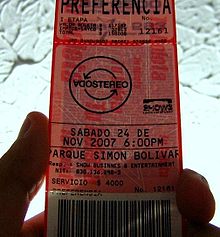 «Me verás Volver». Ticket for the Bogotá (Colombia) show. Soda Stereo reunited one million fans during their 2007 reunion tour.
«Me verás Volver». Ticket for the Bogotá (Colombia) show. Soda Stereo reunited one million fans during their 2007 reunion tour.
The reunification of Soda stereo was a mandatory topic for journalists whenever faced with a former member. So much so, that Zeta Bosio once declared:
One day I dreamed that I was not going to be asked about a Soda reunion!.[44]
In 2007, ten years after the breakup, the band decides to reunite for one time with the goal of accomplishing a grand continental tour. On the 6th of June 2007, the official news came out: Soda Stereo will return to the stage with a sole American tour called Me Veras Volver (You Will See Me Return), a phrase that’s emblematic of their song “En La Ciudad de la Furia”
In early July Sony/BMG released a new compilation album titled Me Verás Volver (Hits & +). The CD contained 18 studio recordings remastered in 2007. The CD did not contain any new material but it did contain a code to receive exclusive web footage such as live versions. The album reached number one in Argentina and in Chile.[5]
On the September 20, 2007, exactly 10 years since their final concert, Soda Stereo gave a long awaited press conference at the Club Museum in Peru St., Buenos Aires, in a historical building designed at the turn of the century by the famous French architect and structural engineer Gustave Eiffel. This was the same building which years before was used as the location for their video of “En La Ciudad De La Furia”.[45][46] They surprised those there with a mini concert of two songs, “Sobredosis de TV” and “En La Ciudad de La Furia,” played in their original form. The song were played solely by the three of them. During the press conference the trio clarified that after the tour they intend on resuming their individual pursuits.
"We Saw You Return." A picture of the show at the Julio Martínez Stadium in Santiago, Chile on the 24th of October of 2007.
The tour was scheduled to begin on October 19 at River Plate Stadium in Buenos Aires, and originally only two concerts were scheduled as well as performances in several American countries. However, from the time the tickets went on sale it became apparent that the original program would be completely overwhelmed and that the band was faced with a huge continent-wide cultural event. The first two shows sold out in only 24 hours (a total of 90,000 tickets). The band quickly added one more show to the schedule,[47] and after three days, the tickets for the first three shows were sold out, so two more shows were added.[48]
Finally on the 19th of October 2007, the time came for the triumphant return of Soda Stereo at the River Plate Stadium in Argentina. A massive banner that contained a large sentence with the name of their songs intertwined was unveiled.[5]
The band was accompanied by one of the main “fourth Soda’s” Tweety Gonzalez (keyboards), as well as Leandro Fresco (keyboards, percussion, and backing vocals), and Leo Garcia on guitars and backing vocals. The concert lasted more than three hours. Soda played a total of 28 songs. The show opened with a recording of “Algun Dia” their cover of Queen's “Someday One Day” meanwhile images of the history of Soda Stereo appeared in the background.
The expected amount of fans attending the five shows was more than 300,000, making Soda Stereo one of the most watched public events in the history of Argentina. Soda became the only band to play more than five times in the Estadio Monumental in Argentina in a single tour. Me Verás Volver featured 22 concerts throughout America including three shows in the US -all but two were sold out[42].
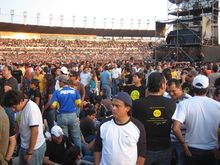 October 27, 2007 Alberto Spencer National Stadium in Guayaquil (Ecuador). The public awaits the return of Soda Stereo.
October 27, 2007 Alberto Spencer National Stadium in Guayaquil (Ecuador). The public awaits the return of Soda Stereo.
In October 2007 Sony/BMG released Comfort Y Música Para Volar on DVD. The DVD included all of the songs recorded for the MTV unplugged session.
On the 21st of December 2007 the last concert was held at the River Plate Stadium in Buenos Aires. Three extra songs were played for this show, “Si No Fuera Por,” “Terapia de Amor Intensiva,” and “Lo Que Sangra (La Cúpula).” The band was joined by Andrea Álvarez for “Picnic en el 4B”, Richard Coleman for “No Existes”, Fabián “Zorrito Vön" Quintiero for “Danza Rota” and “Profugos”, Carlos Alomar for “Lo Que Sangra (La Cúpula)” and “Terapia de Amor Intensiva,” and Gillespie for “Signos” and “Fue.” Cerati returned to use his famous expression “gracias totales,” and after playing “De Musica Ligera.” Finally, Cerati played the riff of “Sueles Dejarme Solo” and smashed his guitar.[49]
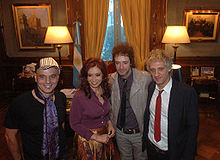 Soda Stereo with the President of Argentina, Cristina Fernández de Kirchner, 2007.
Soda Stereo with the President of Argentina, Cristina Fernández de Kirchner, 2007.
Legacy
The legendary latin rock band
Soda Stereo has been repeatedly considered the legendary Latin rock band.[1][2] It was the first band to come out strongly in the local limits of their country of origin and to consider Latin America as a unified cultural space for the language, including the U.S.. The result was a popular and widespread identification of Latino youth, above countries, which was made for the Anglo-Saxon rock, but not for the Latin rock, rock in Spanish and Latin American rock, different variants the same cultural-musical phenomenon.
In Argentina, a country with a long tradition of Spanish rock mass with a strong local identity (which is called "rock nacional"(national rock)), Soda Stereo was the beginning of a globalization that incorporated local musicians in a great continental power rock up point lead to local analysts to wonder whether "Does it make sense to keep talking about "rock nacional"?".[50] In many parts of Latin America, including Colombia, "Soda Stereo said musicality and poise of a new generation, sought to differentiate themselves from the 'thirties eighties' who liked the Dominican merengue, to begin to listen and sing rock in Spanish."[51] In Chile, Soda not only marked a whole generation with his look, his lyrics and music but the intense emotional relationship developed between the band and its fans, was a decisive factor for "de-nationalize" the group and make it an expression, and not only young people in a particular country, but youth as a sector uniform social issues and common languages, something that rock and roll had not been achieved so far in the Spanish-speaking countries due to language barrier.[52]
Carlos Polimeni told the reporter in an interview: "I was on tour with them. I saw them as heroes disembark and whites were singing in Castilian. " Something which, however, he stressed, did not prevent the first major success was obtained continental "Cuando pase el temblor," a huayno-carnavalito in Andean rock line.[52]
Something similar happened in Peru and Ecuador where the cultural impact of the band has been regarded as "the most important event in the history of rock from those countries placing the band in the collective memory of Latin American music. A similar effect in Nicaragua said that "no one doubts that Soda Stereo is the cornerstone of rock history in Latin America ...» In 1988, Zeta Bosio and the phenomenon commented in a press conference in Venezuela:
"We went to Argentina and started going to Chile, Peru, started climbing and in some countries it happened, we got us and had never been a rock band. They told us that here was a thing of another world and it would not work ... Now is a joy to see what works and what is his own power".
But the multiplier effect of Soda Stereo, beyond their own individual success, as the Latin rock original myth as such, would be concentrated mainly in Mexico. Polimeni is the Argentine who said:
"(It was Soda Stereo) that aroused the Mexican rock. Dozens of groups reacted Mexican: Why do not we do this that come to the Argentine groups? And that erupted in mid 80's in rock, in my view, is the richest and settled across the continent".[52]
Of course the musical-cultural phenomenon that expressed Soda Stereo in Latin America exceeds the band and is inserted into the underlying reasons related to youth identity, that have made rock and roll a global cultural movement, as well as conditions Latin American cultural youth from the decade of the 80 (out of dictatorships, globalization, postmodernism, information society, exacerbating social inequalities.) When Soda Stereo starred in continental Latin rock explosion, every country in Latin America was a breeding ground, made of a new movement of bands ", as it is called in Venezuela.
In the manner of The Beatles and "Beatlemania", Soda Stereo was the band that made it just at the right time, creating aesthetic-linguistic bridges to connect Spanish-speaking youth with the global phenomenon of rock and roll. For this reason the term "sodamanía", used repeatedly to describe the effect of soda on young Latinos, is not inappropriate.[53][54]
The decisive influence of Soda Stereo Latin rock music on the decades of 90 and early twenty-first century has been reflected in the opinion of the leading musicians of the continent:
“ I have been a Cerati fan all my life when he was part of Soda Stereo and before I met him I had already gone to three of his concerts. Both Gustavo [Cerati] and Santana have enriched me, they are my little wonders. ” “ Soda Stereo is one of the most emblematic bands in Latin America. ” “ "El temblor" was the first song of theirs that I heard, it was the first one to be heard in Colombia. I really dig [the reunion]. Why not, if they are alive? They are totally a legend. They have made history for all Latin American youths, and to see them together again, well, will be a great, great event. ” “ Soda Stereo is a wonderful group. I'm very happy for [the 2007 reunion tour]. They are one of the best Latin rock groups. ” In 2002 he created the MTV Latin Awards, a milestone that reflected the identity and the international level reached by the Latin American music, after two decades of growth. As reviewed Latin American press "the most memorable moment of the night was when the Legend Award was awarded to Soda Stereo, the most important and influential band of Rock in Spanish of all time".
Records and achievements
- The First Latin American artist to use the compact disc format (CD) in the album Signos.[58]
- The First Latin American group to have a TV broadcast with stereo sound during the presentation of their album Dynamo in the program "Fax en Concierto", in 1992.
- The First Spanish rock group to play in the United States as the only group of the event.[58]
- The first Spanish-language band to tour Latin America. Formerly the Spanish rock groups rarely left their home country and if they did not obtain much success. Soda Stereo was the first group to exploit the idea of expansion across the region.
- The First Ibero-American band to include an interactive track in a album, in this case with his MTV Unplugged album, Comfort y Música Para Volar, in 1996.
- The first Latin American band in transmit over the Internet a concert (1996), in the Argentinean radio program "Cuál Es?" of the Rock & Pop radio.[58]
- The Me Verás Volver tour (You Will See Me Return), in 2007, with more than one million attendees, is the largest gathering of an Latin American rock band in history.[59]
- In his tour "Me Verás Volver 2007" reached record for perform six concerts in the Estadio Monumental de River Plate on the same tour, beating the previous mark of five concerts of The Rolling Stones
- Before the tour Me Verás Volver, Robbie Williams held the record for most tickets sold in less time in Argentina (River Plate stadium sold out in five days), but the record was broken by Soda Stereo in 2007 to sell two concerts in the River Plate Stadium in less than a day.
- In Peru, as in Argentina, won the "SOLD OUT" in just five days to put tickets on sale, and was organized a new presentation in Lima for the December 9, 2007.
- During the tour Me Verás Volver in Ecuador 2007 were 45,000 spectators present at the Modelo Alberto Spencer Stadium in Guayaquil. The largest concert has been given in the history of Ecuador.
- In Chile is the band that with more people have filled the Estadio Nacional de Chile, surpassing to Los Prisioneros, who held the record with two presentations in 2001.[60]
- Greater attendance at a pay concert in Venezuela. more than 55,000 fans gather at the Hippodrome de la Rinconada in Caracas in 2007, during the tour Me Verás Volver.
- Greater attendance at a pay concert in Colombia. 52,000 people gather Simon Bolivar Park Bogota, in 2007, during the tour Me Verás Volver.[60]
- Greater attendance at a pay concert at the National Stadium, Panama, with 22,000 spectators, the November 27, 2007.[60]
- Greater attendance at a concert at Estadio Chateau Carreras Cordoba, with 48,000 spectators, the December 15, 2007. With this fact the band snatched los Redondos the record he had gotten years ago at the Cordoba stadium.[60]
Solo work
Gustavo Cerati
Cerati worked with Daniel Melero in his 1992 album Colores Santos, he co-wrote and produced most of the songs and although the album was never formally presented, two singles were released, "Vuelta por el Universo" and "Hoy Ya No Soy Yo".[61] Cerati's second solo album was Amor Amarillo (1993), it contained collaborations by Zeta Bosio and Cerati's (then) wife Cecilia Amenábar.[62]
After Soda's separation, Cerati released the studio albums Amor Amarillo (1993), Bocanada (1999), +Bien (2001) and Siempre Es Hoy (2002). In 2002 he released 11 Episodios Sinfónicos that contained some Soda Stereo and solo songs played live with a symphony orchestra. Cerati's last release, Ahí Vamos!, is considered as a back-to-basics return.[63] His last album to date is Fuerza Natural, which changes several things about their previous albums and has been very well received by fans and critics. In May 2010, Cerati suffered an aneyrism/brain damage, and unfortunately his career has been paused up to now. (2011)
Cerati was also featured in Shakira's song "The Day and the Time" in her album called Oral Fixation, Volume 2 in 2005. The Spanish version of this song is called "Dia Especial" and can be found in the 1st volume of Fijacion Oral.
Zeta Bosio
Bosio has had a low profile over the years. He is working with Proyecto Under, an online portal for musicians. He also produced albums with many bands, such as Aguirre and Peligrosos Gorriones.[64] In a recent interview, he declared that he has no interest to play in a band.[65] He is also the artistic director of an independent label, Alerta Records.[66] In 1997 he produced Nacion Hip Hop, a CD compilation of local underground rap artists that is considered[by whom?] the founding stone of Argentine's hip hop scene. He also worked closely with hip hop act Tumbas (who opened for Soda Stereo in their last concert) and DJ Tortuga, who later became part of the experimental hip hop trio Koxmoz.
Charly Alberti
Alberti released only one studio album without Soda Stereo in 1994, Plum, along with his then girlfriend, supermodel Deborah de Corral,[67] and since 1997 Alberti became interested in informatics, he was involved in running his company Cybrel Digital Entertainment, that aimed at generating and implementing content based technologies. He was named an Applemaster for his contributions to the music world.[68]
In 1998, he started two new projects, URL Magazine, a culture magazine, and URL Records, a discographic label. He is also the founder of YeYeYe and Musike, two portals about music and entertainment.[68]
Alberti recently formed another rock band with his brother, Andrés Alberti, and recorded their first album named as the band, MOLE.[69] Alberti stated that he does not want Mole's sound to sound like Soda Stereo, he wants "Mole to live by itself."[70]
Band members
- Gustavo Cerati – lead vocals, lead & rhythm guitar (1982–1997, 2007 (tour))
- Zeta Bosio – bass guitar, backing vocals, additional guitar (occasionally) (1982–1997, 2007 (tour))
- Charly Alberti – drums, percussion (1982–1997, 2007 (tour))
Collaborating musicians
- One of the collaborating musicians that has been most prominent and have long worked with the band is the keyboardist Tweety González, who accompanied the band on most of his career.
Discography
Studio albums
- Soda Stereo (1984)
- Nada Personal (1985)
- Signos (1986)
- Doble Vida (1988)
- Canción Animal (1990)
- Dynamo (1992)
- Sueño Stereo (1995)
Videography
- Ruido Blanco (1988)
- Canción Animal (1991)
- Una Parte de la Euforia (2004)
- El Último Concierto (2005)
- Comfort y Música Para Volar (2007)
- Gira Me Verás Volver (2008)
Live and remix albums
- Ruido Blanco (1987)
- Languis (EP) (1989)
- Rex Mix (1991)
- Zona de Promesas (1994)
- Comfort y Música Para Volar (1996)
- El Último Concierto A (1997)
- El Último Concierto B (1997)
- Gira Me Verás Volver #1 (2008)
- Gira Me Verás Volver #2 (2008)
Compilations
- 20 Grandes Éxitos (1994)
- Chau Soda (1997) (U.S. #46)[71]
- Rock del Milenio (1999)
- Obras Cumbres (2001)
- 20 Éxitos Originales: Soda Stereo (2005)
- Lo Esencial (2007)
- Me Verás Volver (2007)
Notes
- ^ "A 'chetito' is a somewhat derogatory term used by Argentineans to describe someone from the upper class."
References
- ^ a b "La vuelta de la mítica banda Soda Stereo, con día y hora" (in Spanish). Infobae.com. http://www.infobae.com/contenidos/321043-100439-0-La-vuelta-la-m%EDtica-banda-Soda-Stereo-d%EDa-y-hora. Retrieved June 10, 2007.
- ^ a b "Soda Stereo se reivindica como el grupo mítico del rock latinoamericano" (in Spanish). 7dias.us. http://www.7dias.us/noticia/49400/soda-stereo-se-reivindica-como-el-grupo-mitico-del-rock-latinoamericano. Retrieved May 12, 2007.
- ^ "Rock De Argentina". wikipedia. http://es.wikipedia.org/wiki/Rock_de_Argentina. Retrieved September 7, 2010.
- ^ Mercado, Jose Luis. "Mas Que Rock En Español: Las 120 Mejores Canciones del Rock HispanoAmericano de todo Los Tiempos (20-1) (Spanish)" (in Spanish). Rock en las Américas. http://rockenlasamericas.blogspot.com/2009/10/mas-que-rock-en-espanollas-120-mejores.html. Retrieved December 8, 2007.
- ^ a b c d "«Los 250: Essential Albums of All Time Latin Alternative - Rock Iberoamericano" (in Spanish). rockclasicolatin.blogspot.com. http://rockclasicolatin.blogspot.com/2007/12/parte-final-los-250-mejores-discos-del.html. Retrieved April 20, 2011.
- ^ http://rateyourmusic.com/lists/list_view?list_id=85766&show=25&start=0
- ^ http://www.enremolinos.com/foro/soda-stereo-69/rolling-stone-'los-100-mejores-discos-del-rock-nacional'/?PHPSESSID=b84d4b02fd12a105f74b73785792acf2
- ^ "El Comienzo y el Primer Final" (in Spanish). La Capital. http://www.lacapital.com.ar/2007/09/21/escenario/noticia_417818.shtml. Retrieved December 8, 2007.[dead link]
- ^ "Biographía de Zeta Bosio" (in Spanish). Imagen Animal. http://www.imagenanimal.com/biografia/intro/. Retrieved December 8, 2007.
- ^ a b c d e Lernoud, Pipo: Enciclopedia Rock Nacional 30 Años. De la A a la Z, page 206. Buenos Aires: Mordisco, 1996. (Spanish)
- ^ Garcia, Fernando (April 18, 1998). "Tito Alberti: El Otro Baterista" (in Spanish). diario Clarín. http://www.clarin.com/diario/1998/04/18/c-02401d.htm. Retrieved December 8, 2007.
- ^ a b c "Historia de Soda Stereo: Los Estereotipos" (in Spanish). El Galeón. http://www.galeon.com/eltemblor/Historia/1982.html. Retrieved December 8, 2007.
- ^ "¿Cómo Surgió El Nombre De La Banda?" (in Spanish). Planeta Stereo. http://www.planetasodastereo.com.ar/a2.htm. Retrieved December 14, 2007.
- ^ "Soda Stereo: Biografía: Estalla el sifón" (in Spanish). Imagen Animal. http://www.imagenanimal.com/biografia/1984/. Retrieved December 8, 2007.
- ^ a b c d Feijoo, Sebastian (October 13, 2005). "Entrevista en el Pepsi Music Cerati: "A Veces el Rock no Quiere Crecer"" (in Spanish). http://www.terra.com.ar/canales/Pop_Rock/124/124800.htm. Retrieved December 8, 2007.[dead link]
- ^ Peña, Jose E.. "Historia de Soda" (in Spanish). Archived from the original on 2009-10-26. http://www.webcitation.org/query?url=http://www.geocities.com/SunsetStrip/Lounge/6160/HISTORIA.HTM&date=2009-10-26+16:56:59. Retrieved August 30, 2010.
- ^ Andisco, Pablo and B. Lazzaro (2007). "El Rock De Las Cuatro Esquinas" (in Spanish). El Bondi. http://www.elbondi.com/informe/2007-01-01.2133/elinforme.php?cobertura=2133. Retrieved December 17, 2007.
- ^ " Argentinean producer Horacio Martínez is credited with the 'discovery' of Tanguito, Los Gatos and Moris".
- ^ Alfredo Lois
- ^ "El Cuarto Soda" (in Spanish). Rolling Stone Argentina. 2007. http://www.zonadepromesasweb.com.ar/Ver-Noticias/soda_stereo_nota_el_cuarto_soda-480/&tipo=Nota&relacion=Soda%20Stereo. Retrieved December 8, 2007.[dead link]
- ^ Some of the artists who played that show were: Virus, Juan Carlos Baglietto, GIT, Suéter, Zas, Los Abuelos de la Nada, Marilina Ross, Celeste Carballo, and Sandra Mihanovich.
- ^ a b "Soda Stereo" (in Spanish). Rock.com.ar. http://www.rock.com.ar/bios/0/200.shtml. Retrieved December 8, 2007.
- ^ "Soda Stereo: Pagina Oficial: Historia" (in Spanish). http://sodastereo.com/historia/. Retrieved December 10, 2008.
- ^ "Fernet Con Soda" (in Spanish). Diario La Voz del Interior. http://www2.lavoz.com.ar/nota.asp?nota_id=142196. Retrieved December 10, 2007.
- ^ a b "Tras los pasos de Soda Stereo en Córdoba" (in Spanish). Diario La Voz del Interior. December 7, 2001. http://www2.lavoz.com.ar/07/12/01/secciones/espectaculos/nota.asp?nota_id=139629. Retrieved December 8, 2007.
- ^ Bobby Flores
- ^ Flores, Bobby (April 11, 1986). "Temblor en Obras" (in Spanish). Revista Rock & Pop. http://www.zonadepromesasweb.com.ar/Ver-Noticias/soda_stereo_nota_temblor_en_obras-95/Pagina_4/&relacion=Soda%20Stereo. Retrieved December 8, 2007.[dead link]
- ^ Zeiger, Claudio (May 12, 2002). "Bailando Sobre Los Escombros de Carlos Polimeni" (in Spanish). http://www.pagina12.com.ar/diario/suplementos/radar/9-191-2002-05-12.html. Retrieved December 8, 2007.
- ^ "Sitio No Oficial de Soda Stereo. Discografía: Signos" (in Spanish). Zona de Promesas. http://www.zonadepromesasweb.com.ar/Soda_Stereo/Discografia/Oficiales/Signos/. Retrieved December 8, 2007.[dead link]
- ^ "Top 10 Discos En Vivo Argentinos" (in Spanish). Rolling Stone (Argentina). http://my-musik.com/article3953.html. Retrieved December 9, 2007.
- ^ Adaime, Iván. "Doble Vida (Overview)". Allmusic. http://www.allmusic.com/album/r101373. Retrieved April 1, 2007.
- ^ a b Adaime, Iván. "Canción Animal > Overview". Allmusic. http://www.allmusic.com/album/r101372. Retrieved 2007-01-04.
- ^ two years later Sandro would play 40 consecutive shows at the Grand Rex
- ^ a b Kon, Daniel and Robert Costa (Oct 10, 2007). "Soda Stereo: 1982 - 2007, Me Verás Volver" (in Spanish). Aerosoda. http://aerosoda.spaces.live.com/Blog/cns!162B7F502C77AB90!597.entry. Retrieved December 9, 2007.
- ^ Attaque 77
- ^ Perez, Martin (July 20, 2007). "Mucho Más Que Cero" (in Spanish). http://www.pagina12.com.ar/diario/suplementos/radar/9-3960-2007-07-20.html. Retrieved December 10, 2007.
- ^ Adaime, Iván. "Dynamo Overview". Allmusic. http://www.allmusic.com/album/r176493. Retrieved 2007-01-04.
- ^ "Tapa De Sueño Stereo" (in Spanish). Coveralia. http://www.coveralia.com/caratulas/Soda-Stereo-Sueno-Stereo-Frontal.php. Retrieved December 10, 2007.
- ^ "La banda" (in Spanish). Soda Stereo official website. Archived from the original on 2006-04-24. http://web.archive.org/web/20060424034444/http://www.sodastereo.com/labanda/index.html. Retrieved 2007-01-04.
- ^ "A Una Década De Su Despedida Los Veremos Volver" (in Spanish). http://www.rock.com.mx/soda_01_07.html. Retrieved December 10, 2007.
- ^ Cerati, Gustavo (May 2, 1997). "La Carta Del Adiós" (in Spanish). Diario Clarín. http://www.rpp.com.pe/portada/entretenimiento/101614_1.php. Retrieved December 20, 2007.
- ^ Franco, Adriana (1997-09-22). "Tomátelo con Soda" (in Spanish). La Nación. http://www.lanacion.com.ar/77304. Retrieved 2007-02-07.
- ^ Cerati, Gustavo. "Gracias Totales" (in Spanish). Youtube.com. http://www.youtube.com/watch?v=l4Sv-2ytWoM. Retrieved September 20, 1997.
- ^ "Zeta Bosio: No Encontré Nuevos Socios" (in Spanish). Clarín. February 18, 2007. http://www.clarin.com/diario/2007/02/18/espectaculos/c-01365463.htm. Retrieved December 20, 2007.
- ^ Arrascaeta, Germán (September 22, 2007). "Holas Totales" (in Spanish). La Voz del Interior. http://www2.lavoz.com.ar/07/09/22/secciones/espectaculos/nota.asp?nota_id=117057. Retrieved December 11, 2007.
- ^ "Club Musseum" (in Spanish). Sitio Oficial del Club Musseum. http://www.clubmuseum.com.ar/disco.php.
- ^ "Récord Histórico" (in Spanish). Soda Stereo official website. 2007-06-13. Archived from the original on 2007-08-08. http://web.archive.org/web/20070808011746/http://sodastereo.com/noticias/record_historico.php. Retrieved 2007-06-10.
- ^ "Nuevas Funciones" (in Spanish). Soda Stereo official website. 2007-06-15. Archived from the original on 2007-06-26. http://web.archive.org/web/20070626013228/http://sodastereo.com/noticias/nuevas_funciones.php. Retrieved 2007-06-10.
- ^ "Soda Stereo se Despidió Ante Una Multitud" (in Spanish). Imagen Animal. http://www.imagenanimal.com/?ad=index.php. Retrieved December 24, 2007.
- ^ "Libros: "Bailando sobre los escombros" de Carlos Polimeni" (in Spanish). pagina/12.com. http://www.pagina12.com.ar/diario/suplementos/radar/9-191-2002-05-12.html. Retrieved may 12, 2002.
- ^ "Grasas Totales por Javier Aguirre" (in Spanish). pagina/12.com. http://www.pagina12.com.ar/diario/suplementos/no/12-2697-2007-03-26.html. Retrieved may 12, 2002.
- ^ a b c "Libros: "Bailando sobre los escombros" de Carlos Polimeni" (in Spanish). pagina12.com. http://www.pagina/12.com.ar/diario/suplementos/radar/9-191-2002-05-12.html. Retrieved may 12, 2002.
- ^ "La Sodamanía ataca de nuevo" (in Spanish). cuartopoder.cl. http://www.cuartopoder.cl/2007/10/23/la-sodamania-ataca-denuevo/. Retrieved october 23, 2007.
- ^ "Curiosidades de la Sodamanía" (in Spanish). sodafans.com. http://www.sodafans.com/2007/11/curiosidades-de-la-sodamana.html. Retrieved november 2, 2007.
- ^ Original quote: Toda mi vida he sido fan de Cerati cuando él formaba parte de Soda Stereo y antes de conocerlo ya había ido a tres de sus conciertos. Tanto Gustavo como Santana me han enriquecido, son mis pequeños milagros. 2006
- ^ "Gustavo Santaolalla: "Soda Stereo es emblemática"". Netjoven.pe. 2007-09-21. http://www.netjoven.pe/noticias/5446/Gustavo-Santaolalla--quot-Soda-Stereo-es-emblematica-quot.html. Retrieved 2011-07-04.
- ^ a b Yahoo News, Imagen Animal
- ^ a b c "A una década de su despedida los veremos volver" (in Spanish). rock.com.mx. http://www.rock.com.mx/soda_01_07.html. Retrieved June 2007.
- ^ "Soda Stereo: los verás volver" (in Spanish). Diario El Clarín. http://edant.clarin.com/diario/2007/10/19/espectaculos/c-01201.htm. Retrieved october 19, 2007.
- ^ a b c d "Soda Stereo.com Noticias" (in Spanish). SodaStereo.com. http://sodastereo.com/noticias/. Retrieved 2007.
- ^ "Colores Santos" (in Spanish). Gustavo Cerati official website. http://cerati.com/proyectos/colores_santos. Retrieved 2007-01-04.
- ^ "Gustavo Cerati" (in Spanish). Soda Stereo official website. Archived from the original on 2005-02-06. http://web.archive.org/web/20050206134240/http://sodastereo.com/labanda/html/gustavo2.html. Retrieved 2007-01-04.
- ^ Birchmeier, Jason. "Ahí Vamos > Overview". Allmusic. http://www.allmusic.com/album/r835875. Retrieved 2007-01-04.
- ^ "Zeta Bosio" (in Spanish). Soda Stereo official website. Archived from the original on 2006-05-04. http://web.archive.org/web/20060504215204/http://sodastereo.com/labanda/html/zeta2.html. Retrieved 2007-01-04.
- ^ Luna, Verónica; Rodrigo Carretero. "Zeta Bosio" (in Spanish). Desde Abajo. Archived from the original on 2006-12-16. http://web.archive.org/web/20061216212138/http://www.desdeabajoweb.com.ar/zeta.htm. Retrieved 2007-01-04.
- ^ "Staff" (in Spanish). Alerta! DISCOS. http://www.alertadiscos.com. Retrieved 2007-01-04.
- ^ "Charly Alberti" (in Spanish). Soda Stereo official website. Archived from the original on 2006-05-04. http://web.archive.org/web/20060504215211/http://sodastereo.com/labanda/html/charly2.html. Retrieved 2007-01-04.
- ^ a b "Biografía" (in Spanish). Charly Alberti official website. Archived from the original on 2007-03-19. http://web.archive.org/web/20070319054736/http://www.charlyalberti.com/bioabajo.htm. Retrieved 2007-01-04.
- ^ "MOLE". Mole official website. http://www.mole.la/. Retrieved 2007-08-11.
- ^ Zimerman, Gaspar (2007-05-02). "Charly Alberti: "Ser un ex Soda facilita las cosas"" (in Spanish). Clarín. http://www.clarin.com/diario/2007/05/02/espectaculos/c-00811.htm. Retrieved 2007-08-11.
- ^ "Soda Stereo > Charts and Awards". Allmusic. http://www.allmusic.com/artist/p29422/charts-awards. Retrieved 2007-01-04.
External links
Studio albums: Live albums: Compilations Zona de Promesas • 20 Grandes Éxitos • Chau Soda • Rock del Milenio • Obras Cumbres • 20 Éxitos Originales: Soda Stereo • Lo Esencial • Me Verás VolverEPs: Some songs "Cuando pase el temblor" • "En la Ciudad de la Furia" • "De Música Ligera" • "Ella usó mi cabeza como un revólver" • "Planta"Videos Ruido Blanco • Canción Animal • Una Parte de la Euforia • El Último Concierto • Comfort y Música Para Volar • Gira Me Verás VolverRelated people Related articles Labels Categories Members • Albums • SongsStudio albums Live albums 11 Episodios Sinfónicos · Ahí Vamos DVDCompilations Canciones Elegidas 93-04Other albums Singles "Te llevo para que me lleves" · "Pulsar" · "Lisa" · "Raíz" · "Puente" · "Paseo Inmoral" · "Tabú" · "Engaña" · "Río Babel" · "Cosas Imposibles" · "Karaoke" · "Artefacto" · "Crimen" · "La Excepción" · "Adiós" · "Lago en el Cielo" · "Me Quedo Aquí" · "Déjà Vu" · "Rapto" · "Magia"Videos Ahí Vamos DVDRelated people Related articles Labels Sony MusicCategories:- Argentine alternative rock groups
- Experimental rock groups
- Argentine rock music groups
- Post-punk music groups
- New Wave groups
- Musical trios
- Musical groups established in 1982
- Rock en Español musicians
- Musical groups reestablished in 2007
Wikimedia Foundation. 2010.

